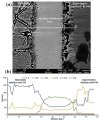The Effect of Holding Time on Dissimilar Transient Liquid-Phase-Bonded Properties of Super-Ferritic Stainless Steel 446 to Martensitic Stainless Steel 410 Using a Nickel-Based Interlayer
- PMID: 36363822
- PMCID: PMC9698928
- DOI: 10.3390/mi13111801
The Effect of Holding Time on Dissimilar Transient Liquid-Phase-Bonded Properties of Super-Ferritic Stainless Steel 446 to Martensitic Stainless Steel 410 Using a Nickel-Based Interlayer
Abstract
The dissimilar joining of martensitic and ferritic stainless steels have been developed that needs corrosion resistance and enhanced mechanical properties. In this study, the transient liquid-phase bonding of martensitic stainless steel 410 and super-ferritic stainless steel 446 was conducted with a nickel-based amorphous interlayer (BNi-2) at constant temperature (1050 °C) and increasing times of 1, 15, 30, 45, and 60 min. For characterization of the TLP-bonded samples, optical microscopy and scanning emission microscopy equipped with energy-dispersive X-ray spectroscopy were used. To investigate the mechanical properties of TLP-bonded samples, the shear strength test method was used. Finally, the X-ray diffraction method was used for microstructural investigation and phase identification. The microstructural study showed that the microstructure of base metals changed: the martensitic structure transited to tempered martensite, including ferrite + cementite colonies, and the delta phase in super-ferritic stainless steel dissolved in the matrix. During the transient liquid-phase bonding, the aggregation of boron due to its diffusion to base metals resulted in the precipitation of a secondary phase, including iron-chromium-rich borides with blocky and needle-like morphologies at the interface of the molten interlayer and base metals. On the other hand, the segregation of boron in the bonding zone resulted from a low solubility limit, and the distribution coefficient has induced some destructive and brittle phases, such as nickel-rich (Ni3B) and chromium-rich boride (CrB/Cr2B). By increasing the time, significant amounts of boron have been diffused to a base metal, and diffusion-induced isothermal solidification has happened, such that the isothermal solidification of the assembly has been completed under the 1050 °C/60 min condition. The distribution of the hardness profile is relatively uniform at the bonding zone after completing isothermal solidification, except the diffusion-affected zone, which has a higher hardness. The shear strength test showed that increasing the holding time was effective in achieving the strength near the base metals such that the maximum shear strength of about 472 MPa was achieved.
Keywords: bonding temperature and time; martensitic stainless steel; mechanical property; microstructure; super-ferritic stainless steel; transient liquid phase bonding.
Conflict of interest statement
The authors declare no conflict of interest.
Figures












References
-
- Amuda M.O.H., Akinlabi E.T., Mridha S. Ferritic stainless steels: Metallurgy, application and weldability. Ref. Modul. Mater. Sci. Mater. Eng. 2016 doi: 10.1016/b978-0-12-803581-8.04010-8. - DOI
-
- OlIver D.C., Sephton M. External corrosion resistance of steel and ferritic stainless steel exhaust systems. J. South. Afr. Inst. Min. Metall. 2003;103:93–100.
-
- Dowling N.J.E., Kim H., Kim J.-N., Ahn S.-K., Lee Y.-D. Corrosion and Toughness of Experimental and Commercial Super Ferritic Stainless Steels. Corrosion. 1999;55:743–755. doi: 10.5006/1.3284029. - DOI
-
- Touileb K., Ouis A., Djoudjou R., Hedhibi A.C., Alrobei H., Albaijan I., Alzahrani B., Sherif E.-S.M., Abdo H.S. Effects of ATIG Welding on Weld Shape, Mechanical Properties, and Corrosion Resistance of 430 Ferritic Stainless Steel Alloy. Metals. 2020;10:404. doi: 10.3390/met10030404. - DOI
-
- Azevedo C., Padilha A. The most frequent failure causes in super ferritic stainless steels: Are they really super? Procedia Struct. Integr. 2019;17:331–338. doi: 10.1016/j.prostr.2019.08.044. - DOI
LinkOut - more resources
Full Text Sources

